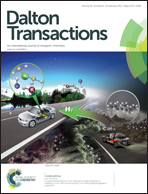Kinetic and mechanistic studies of 1,3-bis(2-pyridylimino)isoindolate Pt(ii) derivatives. Experimental and new computational approach†
Abstract
The rate of substitution of the chloride ligand by three bio-relevant nucleophiles, thiourea (Tu), N,N-dimethylthiourea (Dmtu) and N,N,N,N-tetramethylthiourea (Tmtu), in the complexes: 1,3-bis(2-pyridylimino)isoindoline platinum(II) chloride (Pt2), 1,3-bis(2-pyridylimino)benz(f)isoindoline platinum(II) chloride (Pt3) and 1,3-bis(1-isoquinolylimino)isoindoline platinum(II) complex (Pt4) was investigated under pseudo first-order conditions as a function of concentration and temperature using stopped-flow and UV-Visible spectrophotometry. Computational modeled data of bis(pyridylimino)3,4-pyrrolate platinum(II) chloride (Pt1) were incorporated in the study for comparison. The observed pseudo first-order rate constants for substitution reactions obey the rate law kobs = k2[Nu]. High negative activation entropies and second-order kinetics for the displacement reactions all support an associative mode of activation. The reactivity is dependent on stabilization of the LUMO energy and inversely proportional to the number of phenyl rings added irrespective of the site of attachment. The electron density on the ligand moiety plays a significant role in the substitution behavior of the platinum(II) complexes, as supported by DFT descriptors {electrophilicity index (ω) and chemical hardness (η)}.


 Please wait while we load your content...
Please wait while we load your content...